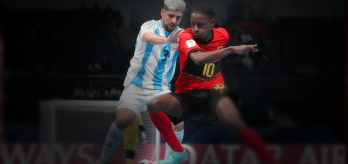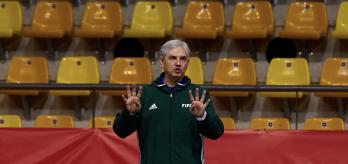This article examines Higuita’s role as a fly goalkeeper — in which a goalkeeper actively joins the attack as an additional outfield player — for Kazakhstan in their run to the quarter-finals of the FIFA Futsal World Cup Uzbekistan 2024™. His contribution is broken down across the different phases of play, exploring what makes him one of the foremost fly goalkeeper specialists. To begin, watch the montage below for a courtside perspective of Higuita in action.
POSITIONAL ATTACK
During a positional attack, a fly goalkeeper can help unbalance compact defensive structures by creating a 5v4 numerical advantage. Higuita’s impact in these situations can be defined by four key elements:
Higuita remains calm under pressure, typically operating as the deepest player, positioned just inside the halfway line. His confidence and poise in this role enable him to control the game’s rhythm, allowing team-mates to support or move into threatening positions without the need to force play.
He has the positional awareness to create numerical overloads while simultaneously recognising the right moments to circulate the ball quickly and exploit them. Effective scanning before receiving the ball allows him to stay one step ahead by reading the opposition’s defensive organisation — whether zonal or man-to-man — and the positioning of team-mates, notably the pivot, who may be positioned centrally or in the corner.
He uses flicks, one-touch, front-foot, or disguised passes to eliminate defensive lines as defenders jump out to press. He also plays skip passes to exploit numerical superiorities. His confidence and accuracy playing with his weaker left foot further enhance his ability to manage pressure from different angles.
Higuita quickly identifies space to shoot, always taking into account the positioning of team-mates, both nearby and close to goal, who can obscure the goalkeeper’s view, create deflections or capitalise on rebounds.
Fast attack
Along with his influence during positional attacks, Higuita is quick to recognise opportunities to launch fast attacks. Typically, this stems from catching or claiming the ball and then rolling it out to dribble at speed into the opposition’s half and exploiting numerical advantages. In addition, Higuita even performs blocks on recovering opposition defenders to give team-mates ahead more time and space.
Escaping pressure
Higuita also plays a pivotal role in helping his team push back an opposition’s high press through his active involvement in the build-up phase. By positioning himself to the side of the court, he stretches the opposition’s press and creates a numerical advantage against their first defensive line. Notably, during the FIFA Futsal World Cup 2024, there was a significant increase in teams defending in a mid or low block, a trend likely influenced by more goalkeepers being willing to participate in possession to push back the opposition’s press.
Protecting the goal in transition
Playing as a fly goalkeeper inherently carries risk, leaving the goal exposed to long-range attempts. Higuita mitigates this, though, by anticipating his retreat in advance as the ball arrives in the finishing zone. When there is no time to recover, he quickly closes down the shooting angle with his body, keeping his arms hidden to avoid a red card. His ability to manage transitions effectively reduces the need for team-mates to commit tactical fouls that often result in yellow cards and bring the team closer to the foul limit.
Set plays
Higuita is a willing option for Kazakhstan during set plays, arriving late from a deep starting position to catch the opposition off guard. His presence alone from set-play situations can also draw defenders’ attention, as his reputation and shooting threat from distance can open space for team-mates to exploit.
Excursus: defensive solutions
While Higuita exemplifies the offensive potential of a fly goalkeeper, it is equally important to understand how opponents can counteract this approach. One illustrative case was Kazakhstan’s clash with Argentina at the FIFA Futsal World Cup 2024, where the South American side pressed high and aggressively to prevent Higuita from entering their half. Teams can employ various pressing strategies to limit the fly goalkeeper’s influence, closing play down one side and creating a "strong side" to contain play.
In addition, the following defensive principles can help restrict the fly goalkeeper’s involvement:
-
Targeting the dominant foot: By closing down a fly goalkeeper’s stronger foot, defending teams can reduce the threat of long-range shots or precise passes.
-
Jumping out to press the goalkeeper when they are moving or running with the ball: Pressing a fly goalkeeper while they are on the move, rather than static, can be effective as they are less composed and more vulnerable to mistakes with limited scanning and passing control.













